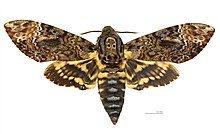Death's-head Hawkmoth
| Death's-head hawkmoth | |
|---|---|
 |
|
| Acherontia lachesis | |
| Scientific classification | |
| Kingdom: | Animalia |
| Phylum: | Arthropoda |
| Class: | Insecta |
| Order: | Lepidoptera |
| Family: | Sphingidae |
| Subfamily: | Sphinginae |
| Genus: |
Acherontia Laspeyres, 1809 |
| Species | |
|
A. atropos - African death's head hawkmoth |
|
A. atropos - African death's head hawkmoth
A. styx - Lesser death's head hawkmoth
A. lachesis - Greater death's head hawkmoth
The name death's-head hawkmoth refers to any one of the three moth species of the genus Acherontia (Acherontia atropos, Acherontia styx and Acherontia lachesis). The former species is found primarily in Europe, the latter two are Asian; most uses of the common name refer to the European species. These moths are easily distinguishable by the vaguely human skull-shaped pattern of markings on the thorax. All three species are fairly similar in size, coloration, and life cycle.
These moths have several unusual features. All three species have the ability to emit a loud squeak if irritated. The sound is produced by expelling air from the pharynx, often accompanied by flashing of the brightly colored abdomen in a further attempt to deter predators. All three species are commonly observed raiding beehives of different species of honey bee for honey; A. atropos only attacks colonies of the well-known Western honey bee, Apis mellifera. They can move about in hives without being disturbed because they mimic the scent of the bees.
Eggs are laid singly under old leaves of a host plant and are green or grey-blue. None of the three species is restricted to a single family of host plant; hosts are typically of the families Solanaceae, Verbenaceae, Oleaceae, Bignoniaceae, and others. The larvae are stout, reaching 120–130 mm, with a prominent tail horn. All three species have three larval color forms: typically, green, brown, and yellow. Larvae do not move much, and will click their mandibles or even bite if threatened. When mature, they burrow underground and excavate a small chamber where they pupate.
...
Wikipedia
